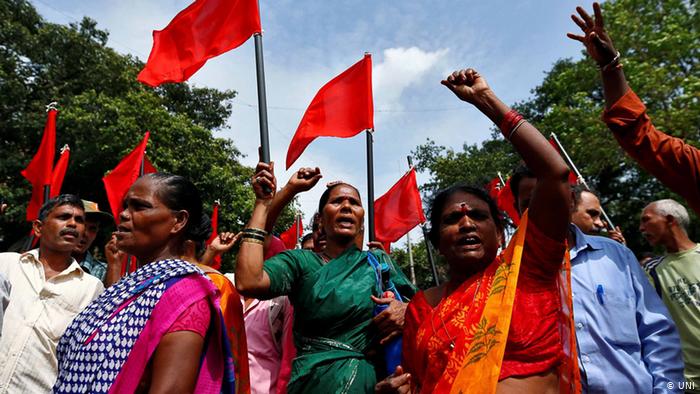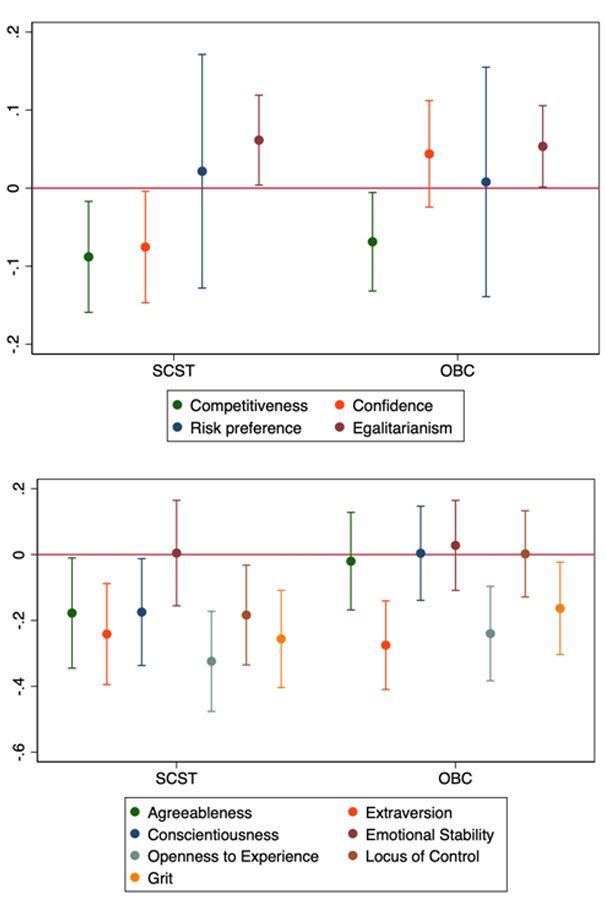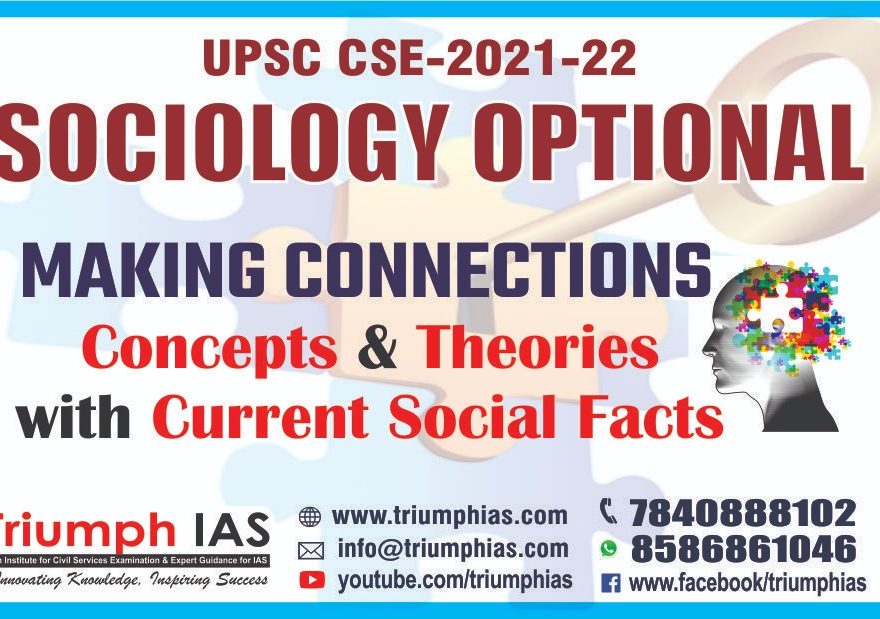While numerous studies have examined gaps in health and educational outcomes across castes, there is little evidence on caste gaps in behavioural preferences and personality traits. Based on incentivised experiments and surveys among 2,000 undergraduate students of the University of Delhi – where certain shares of seats are reserved for historically marginalised social groups – this article shows that considerable gaps exist between lower castes and upper castes.
Historically marginalised and discriminated groups tend to perform worse on typical indicators of achievements and well-being compared to individuals from high-ranking social groups. Differences exist across many constructs of social identities such as race, ethnicity, religion, gender, and caste. The literature on the internalisation of social stereotypes suggests that this is a rather complicated problem to redress. A yawning social divide along identity lines and adherence to choices that confirm identity stereotypes can adversely influence and restrict the choices of minority groups, fostering dominated and sub-optimal outcomes (Akerlof and Kranton 2010). Consequently, there is a vicious cycle of hierarchical social structures accompanied by legacies of discrimination, stigma, and poor self-valuations due to internalisation of negative stereotypes resulting in a perpetuation of poorer outcomes (Tajfel and Turner 1986, Major and O’Brien 2005).
India is a case in point where the lower castes – Scheduled Castes(SCs1) – and Scheduled Tribes2 (STs) have fared worse than the upper castes in educational and occupational attainment (Munshi and Rosenzweig 2006), wages and consumption (Hnatkovska et al. 2012), and business ownership (Deshpande and Sharma 2016). Although reservations in national and state legislatures, local governments, institutions of higher education, and government jobs have had positive impacts among SCs and STs in terms of reducing poverty, improving educational attainment, and access to public goods (see for example, Pande 2003, Chin and Prakash 2011), significant gaps still remain between SC/STs and non-SC/STs, and they continue to be subjected to identity-based violence by upper castes (Sharma 2015). Additionally, a consequence of reservations is that individuals belonging to the lower castes are not viewed based on their own merits, but rather through the lens of their collective stigmatised caste identity (Shah et al. 2006). Therefore, it is plausible that social exclusion and repeated exposure to such discrimination, and differential treatment vis-à-vis reservations, may affect one’s beliefs, perceptions, and aspirations even when there have been marginal economic benefits at the aggregate.
The study
We contribute to the literature on identity economics by examining caste differences in important dimensions of behavioural preferences and socio-emotional traits (Dasgupta et al. 2020). We do so by conducting incentivised experiments and surveys to measure behavioural preferences (such as competitiveness, confidence, risk preferences, and egalitarianism), and socio-emotional traits (including the ‘Big Five’ personality traits of conscientiousness, extraversion, agreeableness, openness to experience, and emotional stability, locus of control3, and grit), among a sample of over 2,000 university students in Delhi, India. These dimensions are especially important in light of current work that shows that labour-market outcomes are not just explained by variations in cognitive skills but also influenced by socio-emotional traits (for example, Deming 2017). Unfortunately, the internalisation of negative self-images has the potential to detrimentally influence exactly these characteristics.
The study was conducted in 2014 with students enrolled in undergraduate programmes across 15 colleges in University of Delhi (DU), where certain shares of seats are reserved for SC/STs and Other Backward Classes (OBCs). Various accounts reveal that higher education institutions are exclusionary in nature and that students from reserved groups experience discrimination at the hands of their upper-caste peers and teachers based on their caste, and stigmatising attitudes remain prevalent (Ovichegan 2014, Deshpande 2019). Therefore, the university environment reinforces the underlying causes of marginalisation.
Using an empirical framework that allows for preferences and personality for a student to be correlated, we find that in almost all reported measures of socio-emotional and behavioural preferences, there exists a considerable gap between the SC/STs and OBCs who face discrimination and the upper castes. In Figure 1 below, we show that relative to the upper-caste students, those belonging to the lower-caste groups, and particularly the SC/STs, not only express lower willingness to compete and less confidence, but they also exhibit lower scores on grit, locus of control, and ‘Big Five’ measures of conscientiousness, extraversion, agreeableness, and openness to experience. There are no significant caste differences in emotional stability. In terms of preferences towards economic redistribution, as one might expect, we find that students from the marginalised groups prefer egalitarian choices. Moreover, in most aspects, OBCs tend to lie somewhere in between the upper castes and SC/STs. Our results are striking and reveal the depth of cumulative effects of years of discrimination along caste lines in India.
Figure 1. Behavioural preferences and socio-emotional traits: Lower castes

Notes: These figures display the estimated marginal effects of caste (SC/ST and OBC) along with the 95% confidence intervals4
Further, our student sample has some variation in terms of family background thereby allowing us to explore whether better socioeconomic status alleviates some of the disadvantages of belonging to lower castes. Children and youth from minority groups are deprived not just because of their poorer socioeconomic status but often because they grow up in environments characterised by low parental income and education, and lack of social support. Our results indicate that higher socioeconomic status and attendance at a private high school do have some compensatory effects for low-caste students but only on a small subset of the personality traits.
Discussion
Our findings are noteworthy as we observe sizable caste-based differences even among students from largely urban backgrounds at an elite university. Moreover, this is consistent with overall patterns documented by the existing literature – that draws upon samples of varying representativeness from around the world – wherein minority groups tend to express lower subjective well-being due to their identity. Our result that low-caste students evaluate themselves lower on personality traits has obvious implications for their academic achievement and labour-market success. Additionally, these findings have special significance after taking into account the importance of early-life circumstances in developing one’s personality and preferences (Falk et al. 2019). In particular, since our results indicate that parental investments need not be sufficient, there is an urgent need for redesigning the current structure of affirmative action policies with a focus on more interventions targeted at an early age to mitigate the long-term consequences of being born into a lower caste family. In addition, mentoring programmes offered to SC/STs and OBCs at university could also potentially help mitigate these gaps.
Notes:
- According to the Indian caste system, Dalits (officially Scheduled Castes) are members of the lowest castes who have been subjected to the practice of untouchability.
- Scheduled Tribes are India’s indigenous tribal population.
- Locus of control measures how much an individual believes their outcomes are influenced by their own actions as compared to external factors such as luck.
- A 95% confidence interval is a way of expressing uncertainty about estimated effects. Specifically, it means that if you were to repeat the experiment over and over with new samples, 95% of the time the calculated confidence interval would contain the true effect.
Courtesy : Utteeyo Dasgupta (Wagner College, New York) , Subha Mani (Fordham University) , Smriti Sharma (Newcastle University) , Saurabh Singhal (Lancaster University).

